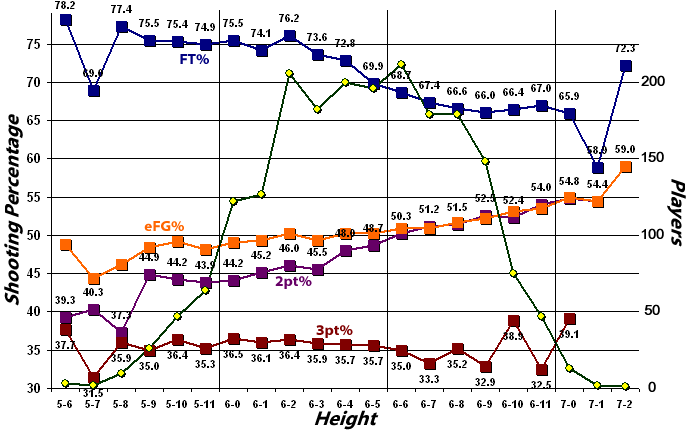Apparently, the relationship between rebounding and height didn’t rock the foundation of the basketball community. The connection between shooting percentage and height isn’t going to create any waves, either.
As seen in the chart below, bigger players have a better two-point shooting percentage and shoot fewer 3’s than their smaller counterparts. We didn’t need to do statistical research to figure that out. But like the rebounding chart, this exercise is not without a couple of noteworthy findings. (Note: some additional background on how this chart was developed can be found in the previous post. Those unfamiliar with some of the terms used in these posts should refer to the Glossary of Terms.)
First, players that shoot fewer 3’s tend to have a better eFG%. This is a broad generalization and perhaps a slight mischaracterization of the chart, but take a look at it. As players get taller, they take fewer 3’s (as shown by the 2pt% and eFG% converging) and yet see a rise in their eFG%. Despite the fact that the percentage of field goals shot from behind the arc increased for the 20th consecutive season in 2006, there remains a place for an effective inside scorer man on the offensive end.
Second, taller players are worse free throw shooters. This shouldn’t be a surprise in itself, but at least now it’s quantified. If your big man is clanging more than his fair share of free throws, cut him a little slack. For me, the deeper issue pertains to why this is the case. Long-time readers of this space know that free throw shooting is a pet peeve of mine. Not the shooting itself, but the perception that modern players are especially poor at it compared to those of long ago.
This is false, and according to the NCAA, the 2006 season tied for the 7th best free throw shooting season since 1948. So if you’re looking for evidence that kids don’t practice the fundamentals, don’t use free throw shooting to help your case.
But if you watch enough games on TV next season, I’m sure you’ll hear an analyst bemoan the current state of free throw shooting. And why is that? I think a part of it is the belief that with enough practice, anyone can be a great free throw shooter. But free throw shooting is a skill like any other. Some have natural talent for it and some don’t, and most are somewhere in between. And yes, practice can produce some improvement. But Joey Dorsey will not become Steve Novak, no matter how hard he tries.
This graph speaks to that to some extent. Big players typically struggle from the line more than guards. Is that because guards practice free throws more? Probably not. You could say that the other things that guards practice lend themselves to better free throw shooting. Or you could say that smaller players generally have better touch than taller players. It’s probably a combination of those two things, and perhaps some other factors I haven’t thought of.
I’d like to focus on the touch aspect of this. Recently, I’ve been thinking that if you want to know what kind of mid-range game an interior player has, free throw shooting can be revealing, because free throw shooting relates to touch, or so I think. This concept relates to smaller players also, except that they usually have a big enough sample of 3-point attempts to give us a more accurate idea of how they shoot. But if this theory has any validity, then there should be relationship between free throw accuracy and 3-point accuracy.
It turns out there is a connection, admittedly weak, between free throw percentage and 3-point percentage. Moreover, in limited cases we can use free throw percentage to assess who may have had circumstances beyond his control in his favor (or against him), and thus is due for a correction in 3-point accuracy this season. More to come…


